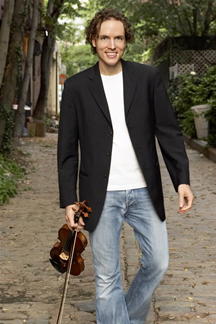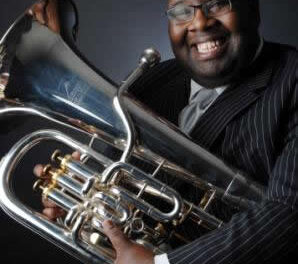The Carolina Theatre was well-filled with a really diverse audience of music lovers for the Chamber Orchestra of the Triangle‘s ambitious all-Beethoven program. Music director Lorenzo Muti’s menu combined a rarely played overture with one of the composer’s most delightful symphonies and his monumental Violin Concerto. The soloist, Tim Fain, was making a welcome return after his January 21, 2007, local COT debut with Prokofiev’s Second Violin Concerto. An important education outreach program was profiled by a pre-concert program in the lobby.
The early music movement of the ’70s encouraged performers of classical period music to abandon large-size “romantic period” orchestras of about 100 in favor of chamber orchestras whose numbers more closely reflected court ensembles of the era. The significant reduction of string players brings the “Harmonie” or aristocratic band of wind instruments into strong relief. The importance of these instruments was evident in every work in this COT concert.
The Overture to King Stephen is one of Beethoven’s most rarely heard works. Austrian Emperor Francis II commissioned the building of a theater in Budapest in 1808 as a sop for rising Hungarian nationalist feelings. Beethoven was commissioned to compose music, including choral parts and melodramas, to texts by August von Kotzebue in celebration of King Stephen I, who founded the kingdom of Hungary in 1000 AD. A stirring musical call to attention is followed by the development of two themes, a lilting Andante con moto featuring solo flute followed by a boisterous Presto leading to a rousing finale. Muti led a good standard interpretation with apt tempos and effective phrasing. Balance among the sections was excellent and the range of dynamics enhanced the dramatic effect of the piece.
Muti led a well-judged interpretation of Beethoven’s wonderfully bucolic Symphony No. 6 in F, Op. 68 (“Pastoral”). Phrasing and tempos were effective and stylish with each of five movements flowing smoothly into the next with the briefest of breaks. String parts were beautifully detailed. The bird calls in the second movement – a quail, a cuckoo, and a nightingale – were strongly characterized by the COT’s superb wind players. Muti’s four violas, three cellos, and single double bass played heroically in the third movement to bring off the building roar of the fourth movement storm; another cello and bass would not have hurt. The fifth movement’s simple shepherd’s song and thankful feelings came off well. Among the many fine solos were those of flutist Allison Dimsdale, oboist Bo Newsome, clarinetist Jim Williams, bassoonist Christopher Ulffers, and principal horn Todd Dimsdale.
Beethoven’s monumental Violin Concerto in D, Op. 61, is one of the core works in any touring virtuoso’s repertoire; it has had quite a number of fine local performances recently. Muti’s soloist, Tim Fain, has racked up some important awards – the Avery Fischer Career Grant and a Young Concert Artists International Award – in addition to appearances in popular media: Fain played the soundtrack for Richard Gere’s violin in Bee Season and appeared on screen, playing in the recent hit film Black Swan. Fain’s intonation throughout the Beethoven concerto was breathtaking whether his high notes were hushed or powerfully projected. His warm tone was gorgeous and his palette of color was kaleidoscopic. His interpretation was well within the norm except for his own cadenzas in which his fantasy stretched the bounds and carried a truly improvisatory quality. One of the delights of this concert was the precise pairings of Fain’s violin with each of the solo wind players – Newsome, Ulffers, Williams, and Dimsdale’s clarion horn – in turn.
Before the concert, evidence of the COT’s community outreach was on display in the lobby. Children from the local KidZNotes program enthusiastically presented samples of their string and choral skills. KidZNotes is based on the model of “El Sistema,” the world-renowned National System of Children and Youth Orchestras of Venezuela. KidZNotes launched a three-year pilot program in East Durham in September 2010 focusing on a small group of about 60 spanning pre-K through 3rd grade. The daytime and after-school enrichment activities began in three Title-1 schools in East Durham. Besides receiving free music instruction, children and their families benefit from field trips to concerts, visits by performing artists, and other complementary activities.












